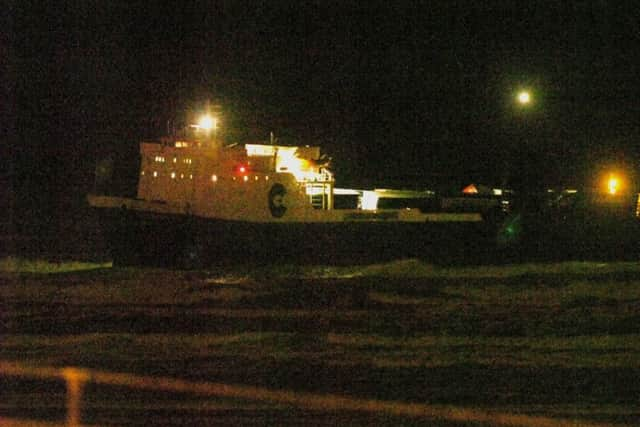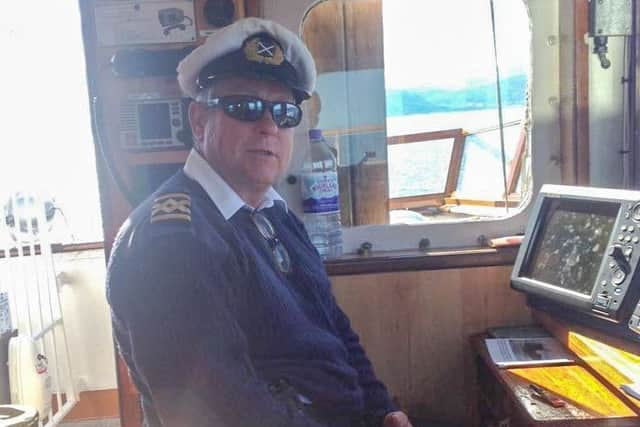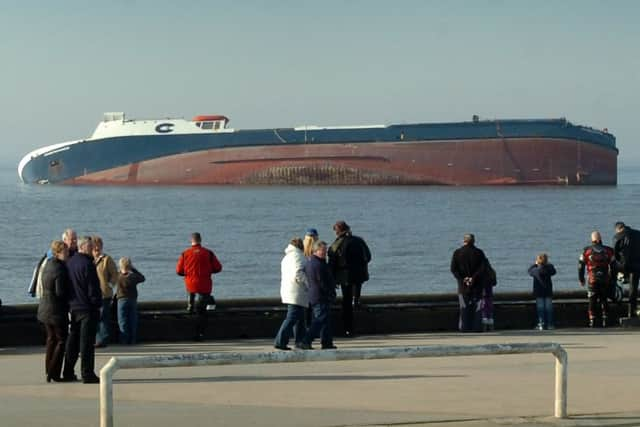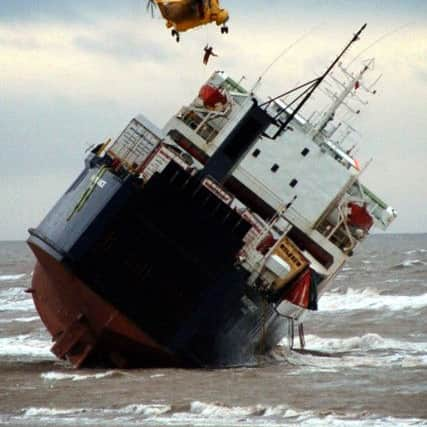RIVERDANCE 10 YEARS ON: The frantic final minutes aboard the ill-fated ferry
and live on Freeview channel 276
Speaking exclusively to The Gazette about the disaster, which drew huge crowds of onlookers to the Fylde coast, Jim Smith revealed how:
• He told jokes and sang ditties to lighten the mood as helicopter winchmen hauled the terrified passengers and crew to safety;
Advertisement
Hide AdAdvertisement
Hide Ad• He believes divine intervention saved the lives of 23 people – with him admitting they were ‘in the hands of God’;


• The doomed ship was hit by TWO massive waves in quick succession that sent cargo flying and the Riverdance leaning heavily to one side; and
• How the 6,000-tonne ship was left ‘very close’ to capsizing with everyone still on board.
Jim was the last man off the Riverdance after he declared a mayday on January 31, 2008, while on the way from Warrenpoint in Northern Ireland to Heysham near Lancaster.
Advertisement
Hide AdAdvertisement
Hide AdThe accident, which left the ship stricken on the beach of Cleveleys for the best part of a year, and the major rescue mission that involved three helicopters, two lifeboats, and a small army of emergency workers on the shore, attracted huge media attention and around 100,000 tourists.


But the 59-year-old has never before told of the panic on board – or revealed just how close to tragedy the Riverdance was after getting into trouble near Lune Deep, a treacherous section of deep sea off the coast.
In an interview to launch five days’ of coverage to mark the 10th anniversary of Riverdance’s crash, which put Cleveleys on the map, the veteran mariner said: “She was very close to going over. A different day; a different outcome.
“There’s always somebody looking out for you. That’s what I always put it down to.”
Advertisement
Hide AdAdvertisement
Hide AdThe Riverdance was renowned for her good seakeeping, and her motion was described as nice and easy as she first set off across the Irish Sea, carrying 54 trailers and several hours behind schedule.


No stranger to the nine-hour crossing, and confident the 31-year-old steel vessel could cope with the rough seas, lashing rain, and gale force winds, Jim retired to his cabin, while several other crew members also rested.
After returning to the bridge, the Scot noticed the main engines were overloaded and reduced speed, remaining on course.
Ninety minutes later, with the weather worsening to conditions described by rescuers afterwards as the ‘worst we have ever seen’, with swells of up to seven metres high, crockery and personal effects belonging to the 19 crew and four passengers crashed about in the accomodation, galley, and mess rooms.
Advertisement
Hide AdAdvertisement
Hide AdTwo trailers driven onto the deck for safe passage slipped from their trestles, loosening the lashings that secured them.


Donning his work gear, the Riverdance’s chief officer found Jim and his chief engineer deep in talks.
The 116-metre-long ship was leaning slightly and needed to be corrected and, alongside another crew member, he set off for the upper deck to check the lashings.
The pair climbed down the stairs and had just got to the bottom when the ship was broadsided by a huge wave, sending it rolling from one side to the next as an alarm on the bridge sounded, seven miles off the coast of Fleetwood.
Advertisement
Hide AdAdvertisement
Hide AdThe engineer and seaman sheltered in the stairwell doorway as the ship tilted violently left and as many of the others on board were thrown off their feet. Before the ship could right itself, a second wave slammed into it, Jim said.
He said: “That’s when the ship rolled even more to port and the cargo in all the trailers broke free.
“That’s when she went down to 45 degrees plus.”


Trailers strained as the varying cargo inside shifted, with the crashing heard even over the mechanical rumbling in the engine room.
Some broke free, sliding across the deck as Jim turned off the auto-pilot and steered to the starboard to escape the brunt of the 80mph wind.
Advertisement
Hide AdAdvertisement
Hide AdSalt water spilled onto the deck as the Riverdance leaned over, while those on board – the majority Polish but all speaking English – pulled on their life jackets and huddled together.
Then the port main engine cut out, leaving the ship even more vulnerable to the wind, sea, and swell, and an emergency call was made to shore.
Had the crew used shaft generators as normal – they rely on the engine to power the ship’s electricity supply – Jim said steering would have been lost and the ship taking the force of the waves.
Instead, they had relied on standalone diesel generators, which continued to work.
Advertisement
Hide AdAdvertisement
Hide Ad“For some reason, I stayed on the diesels,” Jim said. “I haven’t a clue why.”
Operator Seatruck’s crisis management team assembled in the company’s offices in Heysham as Jim, clutching the handrail on the bridge to stop himself sliding across the control room, calmly asked Liverpool Coastguard for tug assistance at 7.41pm, saying the Riverdance was drifting south and in serious trouble.
‘No idea if she will capsize - I’m in the hands of God’
Sue Daintith, who was in charge of liasing with him that night, said: “Initially the ship was listing but they were managing the situation and just needed a tow to port.
“But as it got worse they sent out a mayday.”
Jim added: “You could see the deck was not far away from the water. Later on I worked out we only had a couple of degrees to go. She was very close to going over.
Advertisement
Hide AdAdvertisement
Hide Ad“I was calm inside. I wasn’t panicking. You have everybody looking to you for guidance. You just hold your breath, suck it in, speak calmly, and get on with it.
“There’s no other option.”
Those on board were told they would have to be evacuated, winched towards the safety of the black sky as the troubled behemoth below battled to stay above the mountainous waves.
Trucker Nigel Bucknall, who was bringing his lorry back from its weekly run to Northern Ireland, called his wife to say a final goodbye as the others, including a couple hitching a ride, held each other for comfort.
Mr Bucknall, now 64, said: “I phoned Mary up when I thought I were on my last 10 minutes, and just told her I loved her and we were in a terrible, mad situation-type thing, and the helicopters were on their way.”
Advertisement
Hide AdAdvertisement
Hide AdMary added: “He said how much he loved me and the family and said it was really bad and they were sending helicopters to get them off but he wasn’t sure he’d make it.”
Choppers from the RAF, Navy, and Irish Coastguard were dispatched, with camera footage from one showing one side of the blue and red Riverdance submerged as water lapped onto the top deck.
A nearby tanker, the Steersman, helped with emergency communication after answering an SOS call, in conditions too rough for tugs, while two oil rig support vessels, the Clwyd Supporter and Highland Sprite, also made their way to the scene.
The ship’s crews mustered together on the bridge, with one starting the heeling pump, used to steady listing vessels, before evacuating the engine room.
Advertisement
Hide AdAdvertisement
Hide AdIt was a move that reduced the listing to 20 degrees and was later credited with playing a pivotal role in the success of the rescue efforts.
By 9.10pm both main engines had failed.
Hovering close to the stricken ship as lifeboats from Fleetwood and Lytham’s RNLI stations circled in the water, airmen Lee Turner, Giles Ratcliffe, Rich Taylor, and John Stevens came up with a plan.
Taking off from RAF Valley in Anglesey, their mercy mission had been complicated by the evacuees’ position on the starboard side.
Mr Taylor said: “It was the best place for them to be if it toppled over, but it was the most difficult side for us to winch in.”
Advertisement
Hide AdAdvertisement
Hide AdFlight lieutenant Lee Turner, who piloted the Sea King helicopter, said: “We had to formulate a plan among ourselves to rescue the people onboard.
“It was quite a difficult position for the aircraft. I wouldn’t say it was impossible, but it did take quite a bit of head scratching.”
The passengers – an official report says there were four, the captain insists there were three – followed by four non-essential crew, were rescued by Rich Taylor first, hauled upwards from the wing of the bridge under the glare of the lifeboats’ search lights.
Sliding across the metal work as the ship heaved from side to side, some had to be swung over the railings in order to be saved.
Advertisement
Hide AdAdvertisement
Hide AdMr Taylor later said: “We train for sea rescue every day we are on call, day and night, but we wouldn’t normally practice in conditions as bad as those.
“It was some of the hardest flying I’ve ever been involved with. I’ve done some big jobs before but that was the scariest thing I’ve ever done.”
Jim said: “A few people were quite scared. The second mate in particular was one of the first people to get off the ship.
“He was detrimental to the rest of the crew’s health. He was just panicking big time.
Advertisement
Hide AdAdvertisement
Hide Ad“The passengers looked very scared as well, obviously. It was not a very nice situation for them, or for anyone.”
He continued: “I was actually cracking jokes to try and keep people buoyed up. We had three hand-held VHF radios and I didn’t realise they were on and transmitting the bulk of what we were talking about on the bridge.
“The harbourmaster at Heysham said, ‘I heard you telling jokes’.
“I said I was cracking jokes, trying to make people laugh and take their minds of it.
Advertisement
Hide AdAdvertisement
Hide Ad“I think it was, ‘Why wasn’t Jesus born in Australia? Because he couldn’t find three wise men and a virgin.’”
The atmosphere in the lifeboats below was tense, in weather described as the worst Fleetwood RNLI coxswain Paul Ashworth and his crew – Steve Carroll, Dave Eccles, Stephen ‘Skip’ Frith, Dave Jordan, and later Ian Ellarby, David Butler, and David Ablet – had seen in a decade.
“It was pretty bad, especially because it was night and you can’t see where the waves were coming from,” Mr Ashworth said.
“The most frightening thing is when it’s black because you can’t see what’s happening.”
Advertisement
Hide AdAdvertisement
Hide AdMr Eccles had been with the RNLI for 16 years by the time he clambered aboard the lifeboat in the darkness.
He remembers the weather as ‘horrendous’, with the Riverdance ‘rolling very severely’ as Jim was asked by radio whether he thought it would capsize.
The answer still sticks in his mind: “I have no idea. I’m in the hands of God.”
It’s a sentence Jim also recalls. A seaman since 1977 and a captain since ‘91, he had never declared a mayday before.
Advertisement
Hide AdAdvertisement
Hide AdAnd he said: “There’s always somebody up there looking after you. My granny was up there looking after me. That’s what I put it down to.
“That’s probably a whole load of nonsense but that’s what people think, you know.”
By 10.30pm, the Riverdance had drifted into the shallow water off the Fylde coast and bumped along the seabed until, at 10.50pm during a second winching operation, she grounded at right angles to the beach off the prom at Cleveleys.
The ship continued to roll, and the Royal Navy Sea King helicopter, based at Prestwick with winchman Kevin Regan on board, evacuated a further six crew, leaving a skeleton crew of nine volunteers behind.
Advertisement
Hide AdAdvertisement
Hide AdWith the Riverdance settled upright on the sandy bottom of Cleveleys beach opposite Anchorsholme Lane, the crew prepared to refloat at the next rising tide, checked and resecured the lashings on the trailers, and cleaned up.
Smashed crockery was cleared from the living quarters, the galley was cleaned and washed down, and the cabins were tidied.
Attempts to manoeuvre the ship off the beach failed, and she came to a stop after swinging parallel to the shore with waves crashing against its side. Power was finally lost.
At 5.15am, after another mayday call and an extensive effort to prevent catastrophe, the Riverdance was finally abandoned.
Advertisement
Hide AdAdvertisement
Hide Ad“I spoke to the Coastguard and said, ‘Is there any chance of getting the helicopter back, because I’ve tried to get her off and now she’s at a 45 degree angle on the beach and there’s no way she’s going to get off?’, Jim said.
“They said, ‘We’ll do what we can’. An hour later we starting singing, ‘Why are we waiting?’
“That was just me being funny.”
Those evacuated were flown to Blackpool Airport, emerging from the helicopters in a state of shock as the horizontal rain and wind threatened to sweep them off their feet.
None were seriously hurt, though two were taken to the Victoria Hospital suffering from mild hypothermia. They were not admitted.
Advertisement
Hide AdAdvertisement
Hide AdSome of the survivors were bused to a hotel in Lancaster by Freckleton firm Walton’s Coaches.
Others were put in a taxi and taken home, including Mr Bucknall, who managed to call his wife to tell her was he safe before being sent for an x-ray for bruising.
He later praised his rescuers, and vowed to continue using the ferry service.
Jim, who spent 12 years on the Riverdance and was unable to bring himself to watch its destruction, later told the BBC: “The high winds, the shallow end of the sea, the swell building up, the un-securing of the cargo - it was just the combination, and it just snowballed.”
Advertisement
Hide AdAdvertisement
Hide AdJim went on to skipper the ship’s replacement before his wife’s death four years ago, when he quit his job. He now lives in Cumbernauld, near Glasgow.
He said: “With the nature of the hours I was unsettled for a couple of years, and then she passed away. After about six months, I said, ‘I can’t be doing this’.
“My youngest son was 10 at the time. My eldest son was at sea, and my middle son was at university about to head off for the summer.
“That would have left my 17-year-old daughter in charge of my wee fellow. It was time to be a dad. I was ashore for about three years, just being a dad and a taxi driver.
“It was great.
Advertisement
Hide AdAdvertisement
Hide Ad“I have come back now, working for an agency, and I just need to work four months a year. It keeps me ticking over.
“I still spend a lot of time at home.”
He continued: “I didn’t go down with the ship, but I was the last man off it.
“Two days later, we couldn’t sleep. At five o’clock in the morning I was walking out the hotel in Lancaster and I could see the pavement opening up in front of me.
“You think, ‘Hmmm, is this what captains of past saw? Were they called into this hole?’
“I don’t really know. I think they might have been.
“It was weird.”